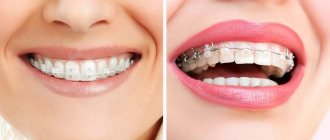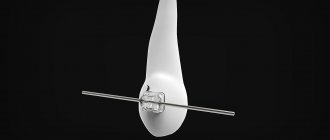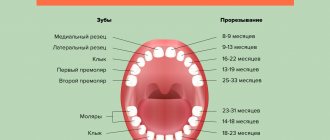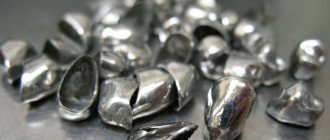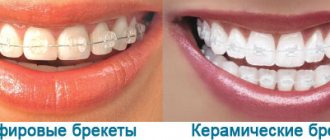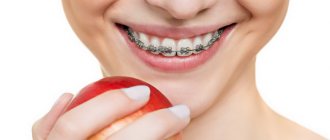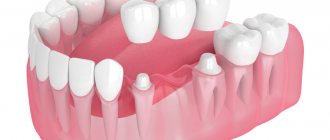Lingual braces are an orthodontic structure that is attached to the dentition from the inside (on the tongue side). This invention in the orthodontic market literally made a breakthrough in the classical understanding of braces. The concept of a bulky and unattractive plate on the teeth has moved aside - lingual braces are absolutely invisible to the eyes of your interlocutors!
Such exclusive invisibility, which not so long ago was not available to those wishing to correct their bite, has ensured that lingual braces are extremely popular. This is an ideal solution for people in public professions who want to correct imperfections in their dentition, but do not want to draw attention to wearing braces. Also, this type of design will help teenagers cope with the psychological discomfort that traditional braces can cause. Lingual braces are not visible, but they will provide their owner with a flawless smile. Why not a dream? Is everything so exemplary or are there certain disadvantages to wearing these orthodontic devices that compensate for their invisibility?
Lingual braces are the second most popular way to correct malocclusion in adults.
Lingual braces are braces that are fixed to the inner surface of the teeth.
They made a breakthrough in orthodontics, eliminating the main problems of classic braces, gaining a huge advantage over other braces. Which? They became invisible to the outside eye. Then even models appeared that began to be called incognito. If you look at the back, inner side of the teeth with lingual braces installed on them, then we will see the following picture:
Any orthodontic design, no matter how useful it may be, has its pros and cons. This was the case at one time with classic braces, which won the love and hatred of millions, and still stand “guardian of the bite,” bringing considerable benefit to patients. But they were first replaced by their improved competitors, then by invisible, lingual ones, who took away their audience from the classic ones. Then lingual braces began to improve - thinner
, lighter
,
more
invisible
, with combined anti-allergic materials. The trend of progress is clear, right?
At the time of publication - before the start of use in patients, if the number of advantages of the model exceeds the number of disadvantages, then this advantage “in the pluses” allows the bracket system to become popular among orthodontists and patients. But progress does not stand still. And braces are being replaced by competitive technologies, which, by their appearance, seem to bring into view all the disadvantages of their predecessors. And if previously users did not pay any attention to some of the disadvantages of lingual brace systems, their current absence in competitive models forces specialists (orthodontists) and users (patients) to talk about them more and more often. So, what are the advantages and disadvantages of lingual braces are being discussed today.
Making a choice
Many people don't know which dental braces to choose. There is no need to rack your brains over this, as your doctor will help you make the right choice. To do this, he will take into account the characteristics of your oral cavity, age, and your wishes. Based on this, he will decide what to choose and offer it to you.
There are different types of brace systems, and you need to choose the right one based on the duration of treatment and other factors. So, if you plan to wear structures for a long time, it is better to choose ceramic or metal types. If you need to adjust your teeth slightly, you can choose sapphire ones. However, it is worth keeping in mind that this material is quite fragile, so if it is worn incorrectly, it may chip. In this case, you should immediately contact your dentist.
Pros and cons of internal lingual braces
The advantages of lingual braces are as follows. There are only three left:
- The first, main advantage
is that lingual braces are not visible.
These are truly internal braces
. To see them, a person either must know that the braces are fixed from the inside, or be a dentist. Or this is a very close person who knows that you are currently undergoing treatment with braces. - The second advantage of lingual braces
is that in a small part (see table below) of lingual braces, as in treatment with aligners, 3D modeling technologies are used. That is, the orthodontist (and the patient) can see the final result of the treatment even before it begins. - The third advantage
of lingual brace systems is that orthodontists can make some adjustments at the treatment stage, that is, this is, so to speak, not doom, not blindly. That is, the patient can participate in this treatment process to correct his bite (unlike classic braces).
What are the disadvantages of lingual braces when correcting malocclusion in adults? There are now five main disadvantages. No, even six:
- The first disadvantage
is that the lingual type of braces is much more painful. That is, there was a study where patients had to rate pain on a ten-point scale. There, calibration was carried out in a certain way so that the results were more or less the same. Patients were treated with conventional braces - one group, another group - with internal, lingual braces, and the third - with aligners (orthodontic aligners, a direct competitor to lingual braces). So, the most painful braces turned out to be lingual braces, and we usually warn patients about this.
- The second minus
is very important. When correcting a bite with internal braces, diction suffers because they are located on the inside, and our tongue is also located on the inside. Well, naturally, diction suffers. The so-called logoneurosis may develop, when a person becomes very nervous because he has incorrect sound pronunciation. - Third minus
. The tongue is injured by the working parts of lingual braces, especially in the first period of time after their installation; patients complain about this very much.
- The fourth disadvantage
is that treatment with internal braces takes longer than with conventional braces. For many patients, the time factor of treatment is the main factor when choosing a method for correcting a bite. - Fifth
, one of the most important disadvantages is that this is
a VERY expensive treatment
. In terms of treatment cost, lingual braces are much more expensive than aligners. Here, firstly, the purchase price is high, and the biggest factor is that this is a very labor-intensive treatment for the doctor, and the labor intensity is included in the cost of treatment. It feels like they are made of gold, the price of lingual braces is so high
Installation process
Braces on the inside take longer to install than systems attached to the outside. There are several stages of their installation:
- At the preparatory stage, all oral problems should be identified and treated.
- At this stage, a plaster cast of the patient's jaw is taken.
- Next, the orthodontist develops a treatment plan and coordinates it with the patient.
- Then comes the process of making custom-made braces.
- The last stage is direct installation.
The whole process may take a month.
Any brace system requires special care. The mouth should be cleaned thoroughly, although hygiene on the inside of the teeth is a bit tricky. For proper care of the structure and oral cavity you will need:
- Special orthodontic toothbrushes.
- Brushing your teeth with a special paste that prevents the development of caries. This point should be performed after every meal.
- Dental brushes that will help remove food debris from braces and wires.
- Dental floss will clean the space between your teeth.
- Irrigator. With its jet you can clean hard-to-reach areas.
- A mouthwash that can be used at any time of the day and outside the home, which is very convenient.
It is also necessary to periodically visit the dentist to clean your teeth from tartar and plaque.
Once the system is removed, the patient is offered a retainer and should wear it for a long time. If these are removable aligners, then the term can extend to life. This is necessary to consolidate the result and fix the teeth in the already corrected position.
Internal braces are difficult to install, so you need to choose a good clinic and a professional orthodontist who has already dealt with such devices.
The sixth disadvantage of lingual braces is the intimate side
Doctors are tactfully silent about this drawback of lingual braces. But it exists. And it causes a lot of problems for owners of lingual structures. This is a continuation of the minus of point #3 - injury. But not the tongue - but injury by parts of the internal braces to the mucous membrane of the sexual partner during intimate caresses: causing micro-scratches with possible infection of the wounds due to insufficient hygiene of the lingual braces. Such statistics are periodically published in the European and American press, where they really and openly talk about it.
For children
Our dental prosthetics and orthodontics clinic installs braces not only for adults and teenagers, but also for young children. Which system is best to choose for your child? Usually a system is installed that consists of 20 “locks”. One half is attached at the top, the other at the bottom. Orthodontics considers this treatment to be the most effective. Metal structures are shown for children. After a few years, the braces are replaced with other, more advanced ones, for example, ceramic ones.
And now - about the competitor of lingual braces
Who has become a competitor to lingual braces? Who has opportunities that are not available in lingual constructions? These are orthodontic aligners, the so-called aligners (aligners in English are “aligners”). The beginning of a new era in orthodontics was heralded by Invisalign. With the advent of aligners, the world was divided into two diametrically opposed camps - “with braces” and “without braces”. And no one from the “braces” camp wants to give up their place on the podium. But new aligner technologies based on mathematical models of the movement of teeth and their nerve endings in the gums, improving computer technologies for modeling treatment results, reducing the influence of the human factor in making certain decisions on the tactics of patient management - step by step, are confidently pushing back braces. which cannot compare anything new to aligners. And what is the result?
By the way, if you have 1 minute and are ready to answer 9 express questions
, you can find out whether aligners are right for you or not.
But let's continue about lingual braces
Do you think that lingual braces only have the five disadvantages that we discussed above? Unfortunately no. Orthodontists have prepared a large comparative analysis of bite correction systems - on the one hand - albeit invisible, but - rigid bulky structures such as braces, and on the other - orthodontic aligners, aligners (they are generally weightless and invisible on the teeth). This analysis also included all the pros and cons of lingual braces. There are more than 70 of them (!). And if you read this analysis in detail - and it is really interesting and written in simple language, then you get the feeling that not only lingual braces, but all braces - although they are popular, they are already a thing of the past, as they say.
Is there a need to give up your usual food?
As a rule, when installing a brace system, the doctor will actually announce “forbidden” foods, and this list looks quite depressing (cookies, chips, seeds/nuts, crackers, chewing gum, pizza, chocolate bars, etc. - everything that can stick to the structure , creating conditions for the proliferation of microbes, or damaging it). But in this case, the doctor’s recommendations should be approached in a differentiated manner: there is a clear reinsurance here, the only thing that is actually required from the patient is caution.
Statistics show that internal lingual braces are a thing of the past
But not in Russia. We are accustomed to the fact that new trends and technologies come to us a little late, 3-5 years. The case with braces is no exception. In European countries, orthodontists note a sharp shift in patients’ interests towards lightweight, invisible aligners on the teeth. There is a decline in orders from orthodontists for lingual braces from brace system manufacturers in Europe. In the USA, by the way, such a decline occurred several years ago and now braces and aligners divide the orthodontic equipment market 50:50
In Russia, the main obstacle is... the orthodontists themselves. Young specialists are already trying to be at the center of all new trends, actively studying and specializing. But older generation orthodontists are more conservative, and the main disadvantage of many of them is computer illiteracy and reluctance to master advanced computer technologies. Very often you hear: “Why relearn? There will be enough braces for our age.” And thus, orthodontists do not leave patients a choice of treatment, offering in cases where invisible treatment is required - lingual braces, which are already becoming obsolete.
Undoubtedly, linval braces have a common big advantage of all brace systems: it is a metal structure that has more powerful force and pressure on the teeth, which means it can cope in areas where it is difficult to heal with aligners. But such pathologies do not occur very often. Since we started talking about all lingual brace systems, let's list them:
- traditional lingual braces (Ormco STB, Inovation L, etc.)
- individual lingual braces Incognito
- custom lingual braces Win
Let's briefly look at their capabilities based on the main parameters, including comparing prices for lingual braces. We will also compare this type of bracket systems with the capabilities of aligners.
Advantages
- aesthetics, quality, invisibility, stability of the result;
- flat shape, the presence of self-ligating mechanisms, which eliminates the stage of replacing ligatures;
- control over the correction process. Internal orthodontic devices give the doctor the opportunity to evaluate the movement of teeth and analyze their location relative to the gums;
- no strict age restrictions;
- do not injure mucous membranes, enamel, do not cause inflammation of gum tissue;
- a significant contact area reduces the risk of braces coming off by 2 times.
The flat configuration of the device does not contribute to pronounced speech impairments; addiction occurs after 10-15 days. The period of correction with lingual equipment is 7-8 months (the period of treatment with vestibular devices is 12-14 months), which is explained by the more effective tension of the metal arch.
Comparison of the main systems of lingual braces and Star Smile aligners
| Traditional lingual braces (Ormco STB, Inovation L, etc.) | Individual lingual braces Incognito | Individual lingual braces Win | Individual aligners Star Smile | |
| Invisibility and aesthetics | Completely invisible from the vestibular side | Completely invisible from the vestibular side | Completely invisible from the vestibular side | Can be seen upon very close examination |
| Discomfort | High because braces are on the inside of the teeth and interfere with the tongue. Long period of adaptation. | High because braces are on the inside of the teeth and interfere with the tongue. Long period of adaptation. | High because braces are on the inside of the teeth and interfere with the tongue. Long period of adaptation. | There is practically no discomfort. Very quickly addictive. |
| Effect on diction | Strong because braces interfere with the tongue | Strong because braces interfere with the tongue | Strong because braces interfere with the tongue | They have virtually no effect on diction since the aligners are very thin |
| Hygiene | Very complex requires the use of special brushes | Very complex requires the use of special brushes | Very complex requires the use of special brushes | Hygiene is normal, no changes |
| Efficiency in treating complex cases | It is possible to treat simple and moderately complex cases. Complex with restrictions. | It is possible to treat simple and moderately complex cases. Complex with restrictions. | It is possible to treat simple and moderately complex cases. Complex with restrictions. | It is possible to treat simple and moderately complex cases. Complex with restrictions. |
| Possibility to temporarily remove equipment | impossible | Impossible | Impossible | Possible during meals and hygiene |
| Effect on nutrition | You cannot eat solid foods, nuts, etc. | You cannot eat solid foods, nuts, etc. | You cannot eat solid foods, nuts, etc. | There are no food restrictions. |
| Hypoallergenic | Possible allergy in rare cases to nickel | Almost never happens since a gold-containing alloy is used | No data | Almost never happens since hypoallergenic plastic is used |
| 3D forecast of the final result of treatment | No | There is only a final position of the teeth | There is only a final position of the teeth | Yes, including the trajectory of the teeth and the position of the teeth on each aligner |
| Average treatment time | 24 months | 18 months | 18 months | 12 months |
| Equipment warranty | No | No | No | Eat. 5 years from the manufacturer |
| Average cost of treatment | 180-200 thousand rubles depending on the level of the clinic | 250-300 thousand rubles depending on the level of the clinic | 230-280 thousand rubles depending on the level of the clinic | 80 – 200 thousand rubles depending on the complexity of treatment and the level of the clinic |
| Expiration date | Standard braces but required approx. 2 weeks for the production of a mouth guard for indirect fixation | Individual braces, production and delivery time from Germany 4-6 weeks | Individual braces, production and delivery time from Germany 4-6 weeks | 4 working days virtual 3D forecast of the final result and |
| Appearance | ||||
| Dependence of treatment success on the doctor’s qualifications | Very high | High | High | Average |
Pay attention to the last point of the table. Dependence on the doctor’s qualifications very tightly “ties” the patient both to the choice of bite correction method and to the quality of treatment using braces.
In the case of treatment with aligners, the entire treatment process can be predicted and presented to the patient on a computer - a 3D virtual model. After this, all the doctor’s competence comes down to competent “service” for the patient, and many doctors do not like this approach - they want to completely subordinate the patient’s treatment to their will and decisions.
The treatment process thus includes subjective assessments of the orthodontist treating you and, as a result, the result of treatment with lingual braces completely depends on the competence of this doctor. In the case of treatment with aligners, the risk of getting a poor-quality result is practically reduced to zero.
Does teeth straightening hurt?
The installation of braces itself is painless, but requires patience because it takes about an hour.
For 7-10 days, teeth may hurt when biting. The body must get used to foreign objects. In general, you live your old life, you just notice pleasant changes in yourself.
Control visits are needed to correct the process and form the correct position of the teeth. Usually after changing the arch the pain goes away within 3-7 days. It all depends on individual sensitivity.
For some, wearing braces is only unpleasant, for others, on the contrary, it is painful, and some do not feel anything.
Why are aligners cheaper than lingual braces?
Both external and internal braces are being replaced by digital technologies in the form of aligners, which are comfortable, invisible and completely predictable. If in the case of lingual systems orthodontists note as a plus such aspects as 3D visualization and the ability to at least partially control the process of correcting the bite, then in the case of aligners the patient ALWAYS sees his result BEFORE the start of treatment and this result is always achieved in 100% of cases.
And of course, a big question arises about the price of lingual systems. As we said just above, lingual braces are the MOST expensive way to correct a bite. And if we consider the same Star Smile aligners as a method of treatment, then the cost of treatment with aligners over the last year has become much lower than the cost of this type of braces.
Why did it happen? Everything is very simple. Where during the treatment process the orthodontist spends his time (which is very expensive for them) carefully considering the method of moving the tooth and correcting the bracket system, in the case of aligners, the entire treatment prognosis was planned in advance by the software. And the doctor’s participation in correcting the bite using aligners becomes less. And the result is almost the same!
Contraindications
Internal braces cannot be installed if:
- there is an allergy to the material from which the structures are made;
- too narrow jaw;
- crowded teeth;
- short teeth;
- bruxism (teeth grinding) appears;
- have periodontitis or gingivitis (inflammation of the gums);
- bite in the process of change, i.e. the patient is younger than 11-12 years old.
Note that such structures can be placed on children and adolescents from 12 years of age, and there is no maximum threshold - a person at any age, be it 40 or 70 years old, can turn to an orthodontist for such help.
Motivation for orthodontic treatment is different for men and women
Regular surveys of adult patients who are considering certain methods of correcting their bite show that men and women motivate themselves differently against braces. But the basis for refusing treatment with lingual braces is their two disadvantages - discomfort
and
price
.
Men speak directly about the discomfort of braces: “Am I a boy, or what?”
Women reduce the problem of wearing braces to a psychological level, preferring aligners:
Is it possible to do without retention and what is it even?
Retention is perhaps one of the most important parts of the entire treatment. Why? Teeth are harmful guys, and they will try to return to their original position, which is comfortable only for them. This is called a relapse. But neither I nor my patient want this. That’s why I really insist on retention, often even suggesting double retention.
What is retention? This is a removable or non-removable device designed to hold the dentition in the desired position. This could be a splint, a retainer (an arch behind the teeth), a night guard, or a plate.
Retainer after braces
What lengths do aligner manufacturers now go to in order to divert patients' attention from braces?
There are good discounts, free consultations, and even free modeling of a future smooth and beautiful smile. But most people, out of established habit, choose not even lingual braces, but ordinary braces, as the main way to correct their bite. In any case, whichever method you choose now, this is the first step towards solving the problem of crooked teeth and entering a new world of opportunities that will open up your beautiful smile.
And by the way, you can sign up for a free consultation and 3D smile modeling in your city by filling out the form below this article. Star Smile specialists will select a specialized orthodontic center for you in close proximity to your residence.
What is dangerous about malocclusion?
When answering the question in what cases it is necessary to install braces and why this is necessary, it is worth familiarizing yourself with the consequences of ignoring the pathological process. Many people mistakenly believe that the lack of timely intervention only affects the patient’s appearance, so it is not so important whether to leave everything as is or still resort to the help of a professional orthodontist.
What will happen if you don't fix it?
What do these anomalies lead to:
- problems with the speech apparatus;
- difficulty swallowing, chewing food;
- disorders of the gastrointestinal tract;
- headaches, migraines;
- diseases of the musculoskeletal system;
- loosening and loss of incisors, canines, molars;
- frequent oral infections.
Do you really need lingual braces as your doctor advises?
Are you ready to carry this pile of iron in the form of lingual braces in your mouth for the entire duration of treatment (a year or two)?
Rub your tongue against them, polish them until they shine, eliminating pieces of food? Braces are uncomfortable and not aesthetically pleasing. Yes, aligners can’t fix everything. But you can have a free consultation with our orthodontists and understand - what if your case can be perfectly cured with aligners? If aligners can do it, then why subject yourself to self-torture with braces? So, we offer a FREE consultation. The Star Smile company operates in more than 70 cities of Russia and will be able to offer you competent consultation with an orthodontist in your city.
Take the first step towards comfortable treatment

